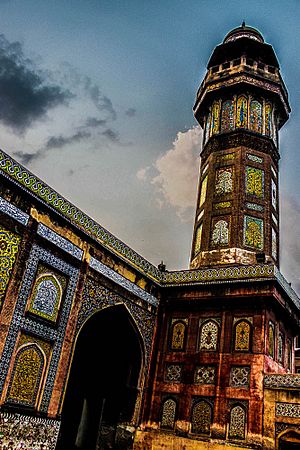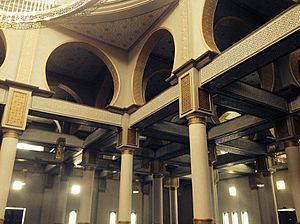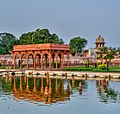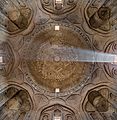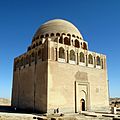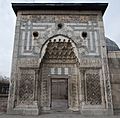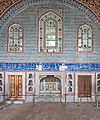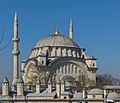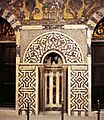Islamic architecture facts for kids
Islamic architecture is a special way of designing and building that grew from the Islamic world. It includes all kinds of buildings, from grand mosques to palaces and homes. This style has been used for hundreds of years, in many different countries where Islam has been important.
Contents
What Makes Islamic Architecture Special?
Islamic architecture has many unique features that make it stand out. Here are some of the main design elements you might see:
- Big Domes: Many buildings have large, impressive domes on top.
- Tall Minarets: These are tall, slender towers, often found next to mosques.
- Large Courtyards: Buildings often have big open spaces in the middle, sometimes connected to a main prayer hall.
- Iwans: These are large, arched halls that are open on one side. They help connect different parts of a building.
- Geometric Patterns: You'll see lots of repeating shapes and designs, like stars and interlocking lines. This is called arabesque.
- Beautiful Calligraphy: Walls are often decorated with elegant Arabic writing, usually from the Quran.
- Symmetry: Buildings are often designed to be perfectly balanced on both sides.
- Ablution Fountains: These are special fountains where people can wash themselves before prayer.
- Mihrabs: Inside mosques, a mihrab is a special niche or alcove that shows the direction towards Mecca, which is where Muslims pray.
- Bright Colors: Many buildings use vibrant colors in their decorations.
- Focus on the Inside: Islamic architecture often pays more attention to the beauty and design of the interior spaces rather than just the outside.
How Islamic Architecture Began
A unique Islamic building style started to develop soon after the Prophet Muhammad lived. This new style took ideas from older building traditions like Roman, Egyptian, Persian, and Byzantine styles.
One of the earliest examples is the Dome of the Rock in Jerusalem, finished in 691 AD. It has a circular dome, vaulted rooms inside, and uses those repeating decorative patterns called arabesques.
The Great Mosque of Samarra in Iraq, completed in 847 AD, is another early example. It had many rows of columns supporting a flat roof, and a huge spiraling minaret (tower) that was very impressive.
Different Styles of Islamic Architecture
Moorish Architecture in Spain and North Africa
The building of the Great Mosque at Cordoba in Spain, starting in 785 AD, marked the beginning of Islamic architecture in Spain and North Africa. This mosque is famous for its amazing arches inside.
Moorish architecture reached its peak with the Alhambra. This was a magnificent palace and fortress in Granada, Spain. It had open, airy rooms decorated in red, blue, and gold. Its walls were covered with beautiful patterns of leaves, Arabic writing, and arabesque designs, often using shiny glazed tiles.
Timurid Architecture in Central Asia
Timurid architecture is considered a high point of Islamic art in Central Asia. Grand buildings were put up by Timur and his family in cities like Samarkand and Herat. These buildings later influenced the famous Mughal architecture in India.
Timurid architecture began with the sanctuary of Ahmed Yasawi in Kazakhstan. It reached its peak with Timur's own tomb, Gur-e Amir, in Samarkand. Many major Timurid buildings, like the Shah-e Zendah in Samarkand, are known for their perfect symmetry. They often have double domes of different shapes, and their outsides are covered in bright, colorful decorations.
Ottoman Architecture in Turkey
The architecture of the Ottoman Empire has its own distinct style. Many great mosques were built by and in the style of a famous architect named Sinan in the mid-1500s, like the Suleiman Mosque.
The 17th-century Sultan Ahmed Mosque (also known as the Blue Mosque) shows how Ottoman architects cleverly used and improved ideas from the ancient Hagia Sophia building, which was built over a thousand years earlier.
Mughal Architecture in India
Another unique style is the architecture of the Mughal Empire in India during the 1500s. This style mixed Islamic and Hindu elements. For example, Emperor Akbar built the royal city of Fatehpur Sikri near Agra in the late 1500s.
The most famous example of Mughal architecture is the Taj Mahal. This stunning building is often called "a teardrop on eternity." Emperor Shah Jahan completed it in 1648 to remember his wife, Mumtaz Mahal. The Taj Mahal used so many precious stones and so much white marble that it almost ran out of money for the empire!
The Taj Mahal is almost perfectly symmetrical. Even a mirror mosque was built in red sandstone to match the main structure.
Persian Architecture's Influence
When Islam first began, it came into contact with the ancient Persian civilization. The capital of the Persian Empire was near the Tigris and Euphrates rivers. Because of this closeness, early Islamic architects often borrowed ideas and traditions from the older Persian empire.
For example, the city of Baghdad was designed based on Persian cities like Firouzabad. In fact, the two designers hired to plan Baghdad were a former Persian Zoroastrian named Naubakht and a former Jewish man from Khorasan, Iran, named Mashallah.
The spiral tower of the Great Mosque of Samarra was also inspired by Persian architecture, like the spiral tower in the middle of Firouzabad, which was an old Sassanid capital.
Images for kids
-
The Mosque of the Prophet, standing on the site of Muhammad's first mosque in Medina.
-
An iwan in the Jameh Mosque of Isfahan.
-
The Dome of the Rock in Jerusalem (late 7th century).
-
The Bibi-Heybat Mosque in Baku, Azerbaijan.
-
The Bāb al-Yaman (Gate of the Yemen) in the Old City of Sana'a, Yemen.
-
Demak Mosque One of the oldest surviving mosques in Indonesia.
-
Almnara Tower Somalia.
-
The 13th century Fakr ad-Din Mosque in Mogadishu.
-
Sultan Qaboos Grand Mosque at Muscat is the main mosque in the Sultanate of Oman.
-
Faisal Mosque at Islamabad, Pakistan designed by Vedat Dalokay.
-
Dome with squinches in the Palace of Ardashir of pre-Islamic Persia.
-
The dome of the Gur-i Amir Mausoleum in Samarqand.
-
Non-radial rib vault in the Jameh Mosque of Isfahan.
-
VIew of the main dome at Humayun's Tomb in Delhi.
-
The bulbous domes of the Badshahi Mosque in Lahore.
-
The interior of the main dome of Shahi Hammam in Lahore.
-
Central domes of the Hagia Sophia.
-
Hünkâr Mahfili (prayer space for the sultan) inside the Hagia Sophia (Turkey).
-
Use of jali screen at Lahore Fort (Pakistan).
-
Muqarnas in the Alhambra.
-
The muqarna of a mosque in Bukhara, Uzbekistan.
-
Intricate design on the muqarna of Wazir Khan Mosque in Lahore.
-
Geometrical tile decoration (zellīj) in the Ben Youssef Madrasa in Marrakesh.
-
Bengali Islamic terracotta on a 17th-century mosque in Tangail, Bangladesh.
-
Design of ceiling in the Mahabat Khan Mosque in Peshawar.
-
Stucco-carved mihrab of Uljaytu at the Jameh Mosque of Isfahan.
-
Mihrab of the Jama Masjid in Delhi.
-
Ottoman minarets of the Sultan Ahmed Mosque in Istanbul.
-
Minaret at the Jama Masjid in Delhi.
-
Medina quarter of Fez, Morocco.
-
Figure-ground diagram of Algiers.
-
Dome in the Friday Mosque of Isfahan, Iran.
-
Ghaznavid Tower of Mas'ud III near Ghazni.
-
Ribat-i Sharaf caravanserai in Khorasan.
-
The Kalyan Minaret in Bukhara.
-
Toghrol Tower in Rayy, south of present-day Tehran, Iran.
-
Mausoleum of Sultan Ahmad Sanjar in Merv.
-
Minaret of the al-Nuri Mosque in Mosul.
-
Yedi Kardeş Tower in the city walls of Diyarbakir.
-
Zinciriye or Sultan Isa Madrasa in Mardin.
-
Hypostyle interior of the Alâeddin Mosque in Konya.
-
Interior of the Çifte Minareli Medrese in Erzurum.
-
Döner Kümbet in Kayseri.
-
Süleymaniye Mosque, Istanbul, designed by Mimar Sinan.
-
One of the chambers of the Topkapı Palace.
-
Interior of Sultan Ahmed Mosque, Istanbul.
-
Entrance gates of the Dolmabahçe Palace, Istanbul.
-
Examples of civil Ottoman architecture in Eskişehir.
-
Yalı is a house or mansion constructed along the shores of the Bosphorus near Istanbul.
-
Reception Hall of Abd ar-Rahman III at Madinat al-Zahra.
-
Kutubiyya Mosque in Marrakesh.
-
Giralda tower in Seville: former Almohad minaret converted into a Christian bell tower.
-
Kasbah Mosque in Tunis.
-
The Court of the Lions at the Alhambra, Granada.
-
Dome of the Hall of Ambassadors in the Alcazar of Seville.
-
Abu al-Abbas al-Mursi Mosque in Alexandria.
-
The Qutb Minar and Quwwat al-Islam Mosque complex in Delhi.
-
Tomb of Shah Rukn-e-Alam in Multan.
-
The Friday Mosque of Ahmedabad.
-
Humayun's Tomb in Delhi, the first fully developed Mughal imperial tomb.
-
Fatehpur Sikri, a palatial complex begun in the 1560s by Akbar.
-
Badshahi Mosque in Lahore.
-
Bibi Ka Maqbara at Aurangabad.
-
The Asfi Mosque of the Bara Imambara complex in Lucknow.
-
Gate of Panembahan Senapati Mosque in Kotagede, Yogyakarta.
-
The Grand Mosque of the Masjid Agung in Central Java, Indonesia.
-
Baiturrahman Grand Mosque, Indonesia.
-
The Menara Kudus Mosque employs a Hindu-Buddhist temple-like structure as a minaret.
See also
 In Spanish: Arquitectura islámica para niños
In Spanish: Arquitectura islámica para niños


